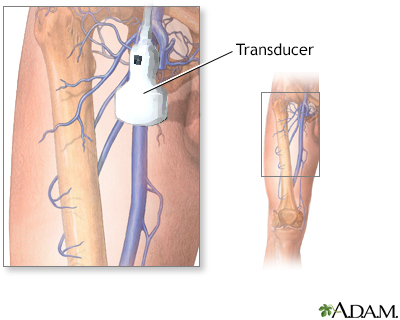Doppler ultrasound exam of an arm or leg
Definition
This test uses ultrasound to look at the blood flow in the large arteries and veins in the arms or legs.
Alternative Names
Peripheral vascular disease - Doppler; PVD - Doppler; PAD - Doppler; Blockage of leg arteries - Doppler; Intermittent claudication - Doppler; Arterial insufficiency of the legs - Doppler; Leg pain and cramping - Doppler; Calf pain - Doppler; Venous Doppler - DVT
How the Test is Performed
The test is done in the ultrasound or radiology department, a hospital room, or in a peripheral vascular lab.
During the exam:
- A water-soluble gel is placed on a handheld device called a transducer. This device directs high-frequency sound waves to the artery or veins being tested.
- Blood pressure cuffs may be put around different parts of the body, including the thigh, calf, ankle, and different points along the arm.
How to Prepare for the Test
You will need to remove clothes from the arm or leg being examined.
How the Test will Feel
Sometimes, the person performing the test will need to press on the vein to make sure it does not have a clot. Some people may feel slight pain from the pressure.
Why the Test is Performed
This test is done as the first step to look at arteries and veins. Sometimes, arteriography and venography may be needed later. The test is done to help diagnose:
- Arteriosclerosis of the arms or legs
- Blood clot (deep vein thrombosis)
- Venous insufficiency
The test may also be used to:
- Look at injury to the arteries
- Monitor arterial reconstruction and bypass grafts
Normal Results
A normal result means the blood vessels show no signs of narrowing, clots, or closure, and the arteries have normal blood flow.
What Abnormal Results Mean
Abnormal results may be due to:
- Blockage in an artery by a blood clot
- Blood clot in a vein (DVT)
- Narrowing or widening of an artery
- Spastic arterial disease (arterial contractions brought on by cold or emotion)
- Venous occlusion (closing of a vein)
- Venous reflux (blood flow going the wrong direction in veins)
- Arterial occlusion from atherosclerosis
This test may also be done to help assess the following conditions:
Risks
There are no risks from this procedure.
Considerations
Cigarette smoking may alter the results of this test. Nicotine can cause the arteries in the extremities to constrict.
Quitting smoking lowers the risk for problems with the heart and circulatory system. Most smoking-related deaths are caused by cardiovascular problems, not lung cancer.
Gallery

References
Bonaca MP, Creager MA. Peripheral artery diseases. In: Libby P, Bonow RO, Mann DL, Tomaselli GF, Bhatt DL, Solomon SD, eds. Braunwald's Heart Disease: A Textbook of Cardiovascular Medicine. 12th ed. Philadelphia, PA: Elsevier; 2022:chap 43.
Gerhard-Herman MD, Gornik HL, Barrett C, et al. 2016 AHA/ACC Guideline on the management of patients with lower extremity peripheral artery disease: executive summary. Vasc Med. 22(3):NP1-NP43. PMID: 28494710 www.ncbi.nlm.nih.gov/pubmed/28494710/.
Lockhart ME, Umphrey HR, Weber TM, Robbin ML. Peripheral vessels. In: Rumack CM, Levine D, eds. Diagnostic Ultrasound. 5th ed. Philadelphia, PA: Elsevier; 2018:chap 27.